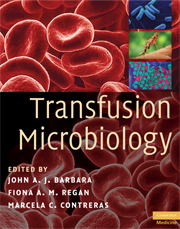Book contents
- Frontmatter
- Contents
- List of contributors
- Foreword
- Preface
- Acknowledgements
- Glossary
- Introduction: Transfusion-transmitted infections, then and now
- Section 1 Agents
- 1 Hepatitis viruses
- 2 Antibody to hepatitis B core antigen
- 3 Herpes viruses
- 4 Retroviruses
- 5 Parvovirus B19 (human erythroviruses)
- 6 Emerging viruses in transfusion
- 7 Bacterial contamination in blood and blood components
- 8 The protozoan parasites
- 9 Prion diseases
- Section 2 Selection and testing
- Section 3 Surveillance, risk and regulation
- Index
- Plate section
- References
5 - Parvovirus B19 (human erythroviruses)
from Section 1 - Agents
Published online by Cambridge University Press: 12 January 2010
- Frontmatter
- Contents
- List of contributors
- Foreword
- Preface
- Acknowledgements
- Glossary
- Introduction: Transfusion-transmitted infections, then and now
- Section 1 Agents
- 1 Hepatitis viruses
- 2 Antibody to hepatitis B core antigen
- 3 Herpes viruses
- 4 Retroviruses
- 5 Parvovirus B19 (human erythroviruses)
- 6 Emerging viruses in transfusion
- 7 Bacterial contamination in blood and blood components
- 8 The protozoan parasites
- 9 Prion diseases
- Section 2 Selection and testing
- Section 3 Surveillance, risk and regulation
- Index
- Plate section
- References
Summary
Parvovirus B19 (B19V)
Definition and characteristics of agent
Parvoviruses are small, 20–25 nm icosahedral viruses (see Figure 5.1), encapsidating a linear single stranded DNA genome of approximately 4000–6000 nucleotides. The family (Parvoviridae) is divided into two subfamilies based on their host species and viral coding strategies, the Parvovirinae that infect vertebrates, including fish, birds, reptiles and mammals, and the Densovirinae that infect insects. The Parvovirinae are similarly divided into five genera, Parvovirus, Dependovirus, Erythrovirus, Bocavirus and Amdovirus, based on the number of promoters, their transcription map, the similarity of the 5′ and 3′ terminal repeat sequences, and their sequence homology (Fauquet et al., 2005). Several different parvoviruses have been identified in humans, including adeno-associated viruses (AAVs), Parv4 (Jones et al., 2005) and Parv5 (Fryer et al., 2006), human bocavirus (Allander et al., 2005), and parvovirus B19 (B19V) (Cossart et al., 1975), but only parvovirus B19 has definitively been shown to be a human pathogen.
B19V was the first member to be described and is the type species of the genus Erythrovirus. The virus has a genome of 5596 nucleotides, consisting of an internal coding sequence of 4830 nucleotides, flanked by identical terminal repeat sequences at the 5′ and 3′ end of 383 nucleotides which form the imperfect palindrome and hairpin structures necessary for DNA replication and encapsidation.
Sequence conservation and parvovirus B19 genotypes
The B19V genome is relatively well conserved, with approximately 10% sequence variation between isolates, but has three distinct genotypes (Servant et al., 2002).
- Type
- Chapter
- Information
- Transfusion Microbiology , pp. 67 - 74Publisher: Cambridge University PressPrint publication year: 2008



